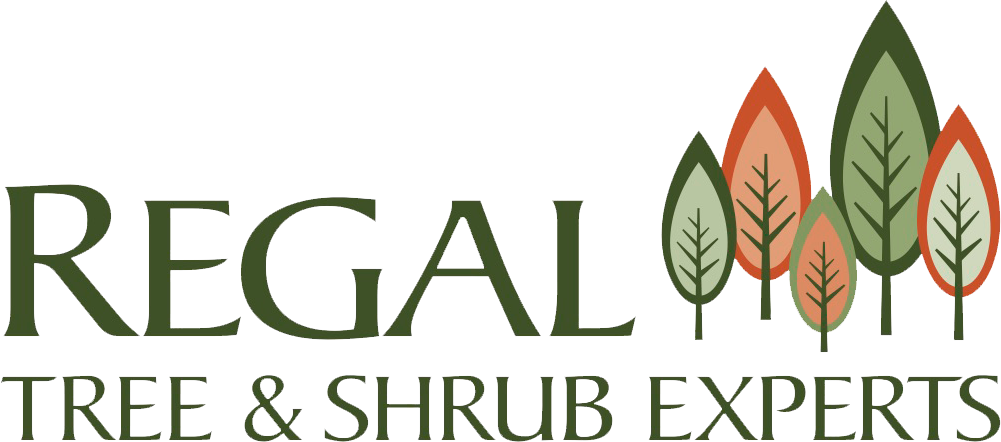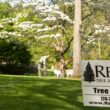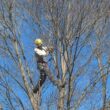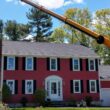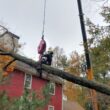As homeowners in the greater South Easton area, we often find ourselves in a constant dance with nature, taming the wild elements of our yards to create a harmonious and welcoming outdoor space. Among the many challenges we face, managing the growth of our trees can be a particularly daunting task. Trees, with their majestic presence and tranquil shade, are cherished members of our landscapes. However, they can sometimes outgrow their allotted space or become unruly, posing potential hazards to our homes and surroundings.
In this article, we’ll tour the world of plant growth regulators with specific attention on tree growth regulators (TGRs), a valuable tool for homeowners seeking to maintain the beauty and safety of their outdoor spaces. We’ll explore the fundamentals of TGRs to understand:
- What tree growth regulators are
- How TGRs restrict tree size
- The many benefits TGRs offer homeowners
- The practical landscape issues TGRs can address
- How tree growth regulators are formulated and applied
So, whether you’re dealing with a towering oak, a sprawling maple, a bountiful fruit tree, or a delicate ornamental, this guide will equip you with the knowledge that strikes that perfect balance between nature’s grandeur and your home’s tranquility. Let’s start by unraveling the mystery of tree growth regulators and how they work.
What are Tree Growth Regulators?
Tree growth regulators, often referred to as TGRs, are an invaluable resource for homeowners looking to manage the size and growth rate of their trees. These products, which have gained popularity in recent years, offer a non-invasive and eco-friendly alternative to traditional tree pruning and removal methods. But what exactly are tree growth regulators, and how do they influence the growth of trees?
TGRs are plant hormones that regulate various processes in plant growth and development. Both naturally occurring and synthetic versions influence functions like cell elongation, flowering, fruit ripening, dormancy, and more by altering internal hormone balances.
Man-made regulators deployed in arboriculture are designed to slow vegetative growth when applied to trees. Common application methods are spraying a diluted regulator solution directly on leaves or drenching the soil around the tree’s base to uptake it through the roots. Depending on the product, a single application can suppress growth for up to 3 years.

Tree growth regulators have a dramatic effect on tree growth as displayed in this side-by-side comparison of treated and untreated trees.
How Do Growth Regulators Restrict Tree Size?
Today’s most advanced growth regulators for trees work by inhibiting the synthesis of gibberellin, one of the primary natural hormones controlling cell expansion and shoot elongation.
Gibberellins stimulate new cells to elongate as growth occurs. When a regulator restricts gibberellin production, cell division continues, but the resulting cells remain compressed. This shrinks internode length, so treated trees extend shorter, more compact shoots and branches.
Regulators essentially slow vertical and horizontal reach to keep trees a more manageable size in confined urban spaces. But intriguingly, the impacts cascade deeper by triggering other physiological changes in trees.
The Surprising Side Benefits of Plant Growth Regulators
Curtailing gibberellin sets off a chain reaction of shifts in treated trees:
- One result is increased chlorophyll and phytol production, creating darker green leaves
- Likewise, more abscisic acid is synthesized. This hormone limits leaf pore openings to conserve water
- Thicker leaves with more pores and hairs further reduce transpiration
- Better water regulation to reduce drought stress
- Obstruct of enzymes fungi and bacteria need, enhancing disease resistance
- Better tree branching and increased fruit production
This dual impact explains the surging interest in tree growth regulators for urban and suburban canopy management. Along with lessening pruning cycles, tree growth regulators given at planting or early in a tree’s life can protect long-term investments like your home.
So beyond moderating untamed growth, regulators deliver a host of secondary perks. Trees become healthier, more drought tolerant, and more resistant to common urban tree pathogens.
You may still be wondering what practical issues can be addressed with tree growth regulators. Here are a few to consider:
- Growth control to avoid shading a pool or deck
- Growth control in crowded landscapes
- Controlling growth in right-of-way and commercial settings
- Reduced encroachment on utility lines and public spaces
- Prevent trees from overshading golf course greens

The tree growth regulator being applied will limit the trees growth leading the benefits associated with reduced growth.
Finding the Right Regulator Formulations and Application Methods
Various formulations and active ingredients of plant regulators exist. Extensive research determined paclobutrazol to be the safest and most effective for trees. It’s applied by either drenching the soil around the tree’s base or injecting a solution into the ground, typically by a professional arborist or other tree care expert.
Because response varies by tree species, certified arborists are best able to determine optimal dosages and timing. Overdoing regulators or applying them improperly can leave trees stunted. Luckily, regulators are mobile within trees for only about three months before degrading. So, impacts are reversible if misapplied.
The Future of Tree Growth Regulators for Homeowners Growth Regulators
Plant growth regulators are important tools for today’s tree service companies. Healthier trees with reduced risk of pests, disease, and drought are well worth the moderate size control regulators provide.
Maximizing tree vigor through innovative care ensures greener, safer, more resilient suburban landscapes.
Can Your Trees Benefit from Plant Growth Regulators?
Call Regal Tree and Shrub experts today at 774-719-2450. Our certified arborists and expert team can evaluate your trees and determine if tree growth regulators are an appropriate treatment for your growing trees. We proudly serve Bristol, Norfolk, Middlesex, and Plymouth counties, Massachusetts, and Providence County, Rhode Island.
